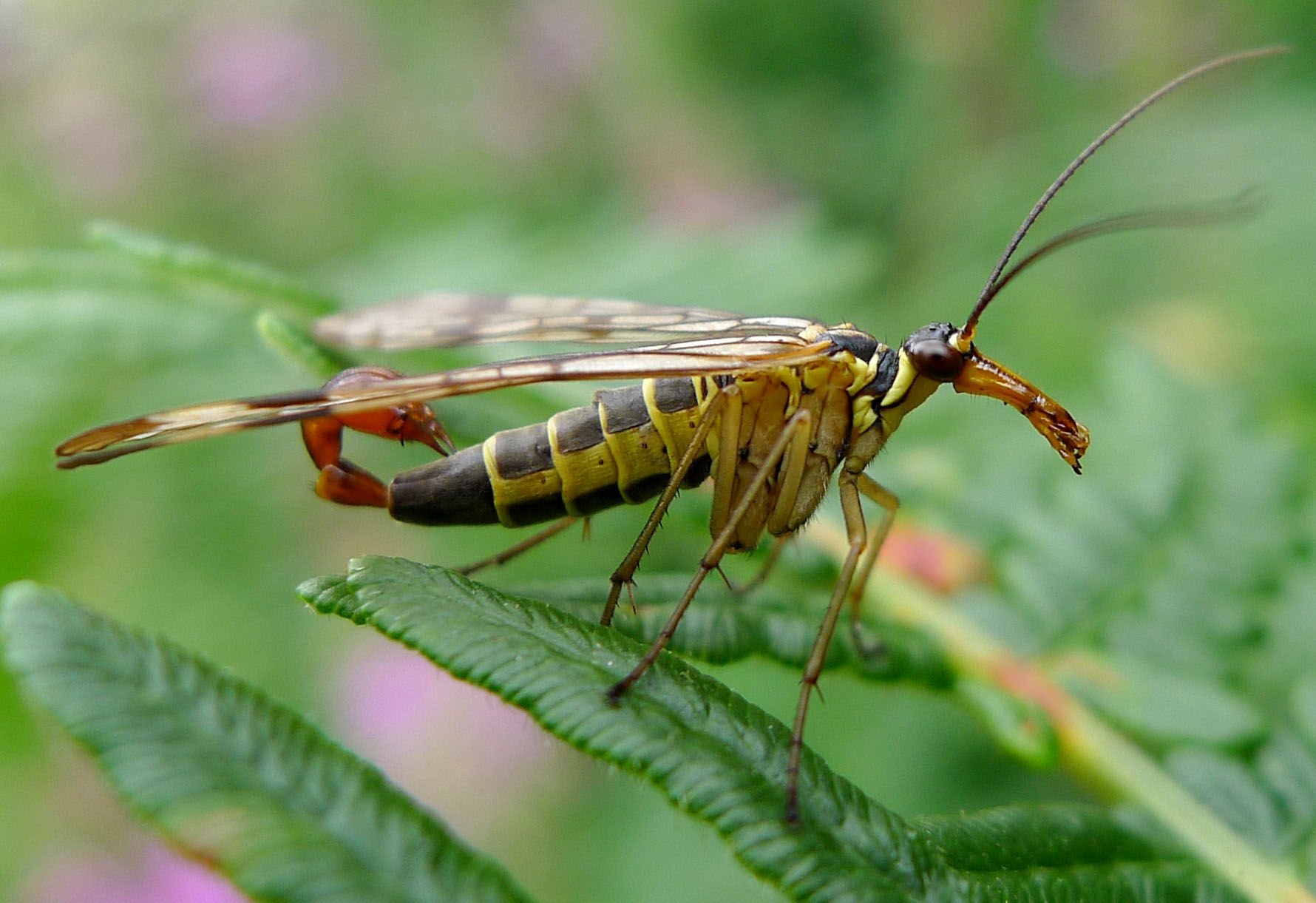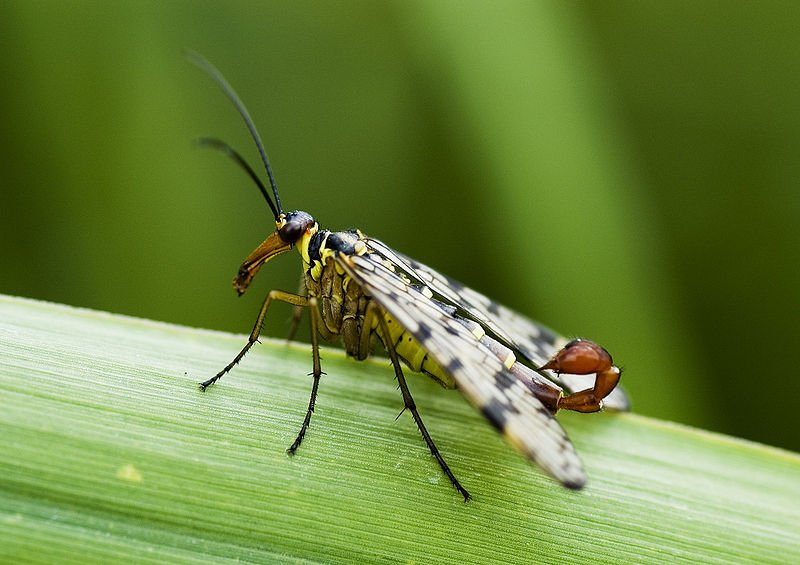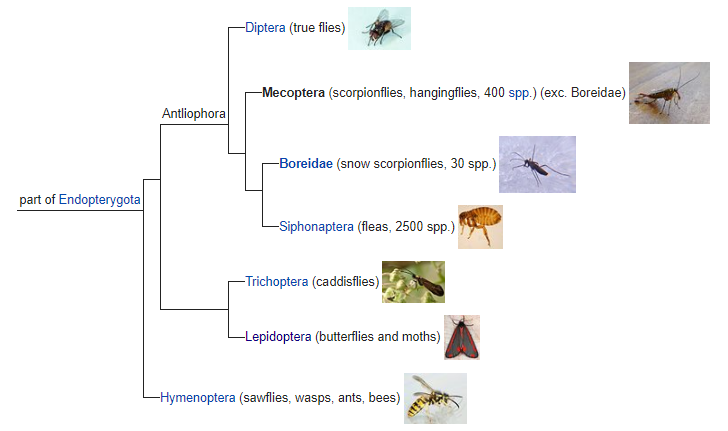 Male P. communis (credit)
Male P. communis (credit)
The scorpion-fly hybrid thing depicted above is as you would expect known as the common scorpionfly.
Scientifically described as Panorpa communis, it belongs to an ancient group of insects known as "Mecopterans", with the earliest known members of the order being the Nannochoristidae of Upper Permian age, about 250 million years ago.
If you are unfamiliar with the species I bet you have a few questions like..Does it sting? Is it related to scorpions? Is it related to flies? Don't worry, all your questions will be answered, just keep on reading! Now, let's learn more about this bizarre creature:
Where Can I Find One?
The species is native to Western Europe and adults are usually found in hedgerows, nettle beds and well wooded areas.
Here's a map from inaturalist.org with a bunch of self-reported observations if you decide to go out and find one for yourself.

Self reported sightings of P. communis (credit)
Please note, you have to wait a few months as the adult stage appears from May to September :p
What's With The Sting? Is It Poisonous?
First, let's clear up some things. The "sting" is only present on males. Here's how a male looks like:
 Male Scorpion Fly (credit)
Male Scorpion Fly (credit)
And here's how a female looks like:
 Female P. communis - No sting (credit)
Female P. communis - No sting (credit)
I think now you might be able to guess what the sting actually is! It's a pair of claspers (a structure found in some groups of animals) that is used for holding the female during mating. In other words, it's just a part of the male genitalia! And no, their penis doesn't sting so you have nothing to be afraid off if you ever see one.
Is It Related To Scorpions or Flies?
Despite their common name (which only refers to their appearance) they are not at all related to scorpions although they are cousins to true flies (Diptera).
As mentioned before, P. Communis belongs to the order Mecoptera which has a special importance in the evolution of the insects:
Two of the most important insect orders, Lepidoptera (butterflies and moths) and Diptera (true flies), along with Trichoptera (caddisflies), probably evolved from ancestors belonging to, or strictly related to, the Mecoptera. Evidence includes anatomical and biochemical similarities as well as transitional fossils, such as Permotanyderus and Choristotanyderus, which lie between the Mecoptera and Diptera. The group was once much more widespread and diverse than it is now, with four suborders during the Mesozoic.
The Mecoptera and Siphonaptera (fleas) share features such as the production of the rubbery cuticle material resilin and panoistic ovarioles which have germ cells forming a continuous tube in place of the usual nurse cells. The Mecoptera are related to these other insect orders as shown in the cladogram, based on a 2008 DNA and protein analysis of 128 flea taxa from around the world. The Boreidae (snow scorpionflies) are the sister clade to the Siphonaptera, so the Mecoptera as traditionally understood is paraphyletic, though the rest of the order forms a clade.[credit]
Here's a graph showing the relationship between the Mecoptera, butterflies, flies, fleas and other insects:

(credit)
Some Other Quick & Interesting Facts
- Adults are about 3 cm long and have a wingspan of about 3.5 cm.
- Their diet mainly consists of dead insects, sometimes stolen from spider webs. Occasionally they also have a live aphid snack.
- Although capable of flight, adults rarely fly and spend most of their life crawling on damp and shady parts of the plants they inhabit.
The End (For Now)
So I think I covered all the basics you need to know about this weird looking critter! Like always, don't forget to check the various links inside the post if you want to learn more about it! Below you will find some more cool videos if you want to see the creature in action.
Videos
 More Strange Animal Stuff
More Strange Animal Stuff
If you enjoyed reading this post I am sure you will love some of my previous work:
- Hagfish Have One Of The Weirdest And Coolest Defense Mechanisms
- Weird MRI Photos, 3-Eyed Beetles, Deep Sea Creatures And Other Cool Animal Stuff
- Can You Guess What Animal Has The Biggest Penis In The World?
- Meet The World's Strangest Ants
- The Squid With The Human-Like Teeth! (Promachoteuthis sulcus!)
- Halloween Special: A Real-Life Monster Compilation
- Alien-Like Moth With Tentacles Terrifies The Internet - But Is This Creature Real?






